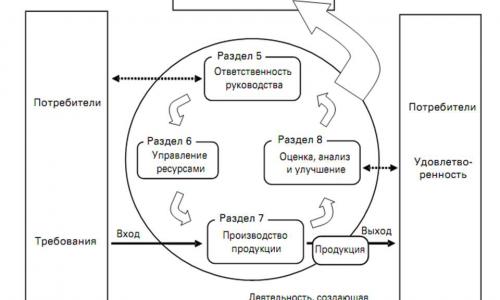What is MS ISO 9000?
ISO (ISO - International Organization for Standardization) - International Organization for Standardization, is developing standards in various areas (intellectual, scientific, technical, economic).
MS ISO 9000 - series (Group) international standards (MS) in the field of quality management.
The purpose of ISO 9000 - the creation of an effective system of management of the organization, aimed at achieving results, customer satisfaction and other stakeholders (employees, society and the state).
The uniqueness of the standards is that they are applicable to any company that manufactures products, provide services or engage in any activity (governments, ministries, educational institutions, industry, airports, etc.)
The composition of the latest version of ISO 9000 consists of 4 main standard.
MS ISO 9000: 2005 - Quality Management Systems. Fundamentals and vocabulary.
MS ISO 9001: 2008 - Quality Management Systems. Requirements.
MS ISO 9004: 2009 - Quality Management Systems. Guidelines for performance improvements.
MS ISO 19011: 2011 - Guidelines for auditing QMS and / or the environment.
In the MS ISO 9000 reflected a fundamentally new approach to the work: the quality depends not only on the test results of finished goods / services (technical control), but the conditions of its production (provision) and the organization as a whole.
A feature of the standard ISO 9001: 2008 is that it places demands not to the quality of products / services directly, and to the system of organization management (quality management system, ie QMS), which in turn provides the required level of quality and stable products / services.
Terminology for the QMS is set to MS ISO 9000: 2005.
Quality - is the ability of the various characteristics of the goods / services to meet the demands of consumers (and / or other interested parties).
The structure of the QMS
The structure of the QMS according to ISO 9001: 2008 consists of four main blocks (Figure 1):
management responsibility,
resource management,
life cycle processes,
measurement, analysis and improvement.
To create the organization's QMS must:
- identify the basic processes of activity;
- determine the sequence and interaction of processes;
- determine criteria and methods needed to ensure efficiency, both work and management processes;
- ensure the availability of resources and information necessary to support the operation and monitoring processes;
- monitor, measure and analyze the processes;
- take the measures necessary to achieve planned results and continual improvement processes.
Figure 1 - Model of quality management system based on the process approach
Documentation of the QMS
A requirement of the standard ISO 9001 is documenting the organization's QMS.
QMS documentation - a set of documents required to build and maintain the QMS.
QMS documentation should be submitted to:
- documented statements of policy and objectives in the field of quality;
- the quality manual;
- documented procedures:
- "Document Management",
- "Records Management",
- "Control of nonconforming product",
- "Internal Audit",
- "Corrective action",
- "Preventive action";
- documents needed by the organization for effective planning, implementation and management processes;
- records.
Quality Policy is the basic document of the system. The Policy defines the organization's leadership in public key priorities and values, which it will adhere to all of its stakeholders (customers, employees, suppliers, society, etc.).
Purpose of QMS
QMS is designed to ensure the quality of services and "tune" is the quality of the expectations of consumers. In this case, the main task of the JMC - not control each individual service, and create a system that will not allow the emergence of errors leading to poor quality of services.
Implementation of QMS can achieve the following:
- coherence;
- stability;
- professionalism;
- decline of marriage;
- reduction of losses;
- quality assurance,
as a result of consumer confidence.
Stages of development, implementation and certification of QMS
The development and implementation of QMS includes the following steps:
- Strategic decision-making senior management
- Creation of a working group
- Education Working Group
- Phased development documentation
- Implementation Documentation
- Internal audit
- Corrective and preventive actions
- Analysis of QMS by management
- The choice of the certification body
- The certification audit and certification of ISO 9001
- Conducting annual supervisory audit
Why do I need a certificate?
Availability of ISO 9001 certification means that the company has implemented management system focused on customer satisfaction.
Certificate of QMS ISO 9001: 2008 provides advantages such as:
- the opportunity to work on the international market, since there is a growing list of services / products subject to mandatory certification;
- confidence on the part of consumers and other stakeholders in the stability of the quality of services / products;
- participation in tenders;
- for public / military order;
- relief usloviypolucheniya licenses / permits;
- attracting investments / loans;
- improving the image of the company;
- implementation of international loans / investments;
- increase efficiency of the enterprise.


